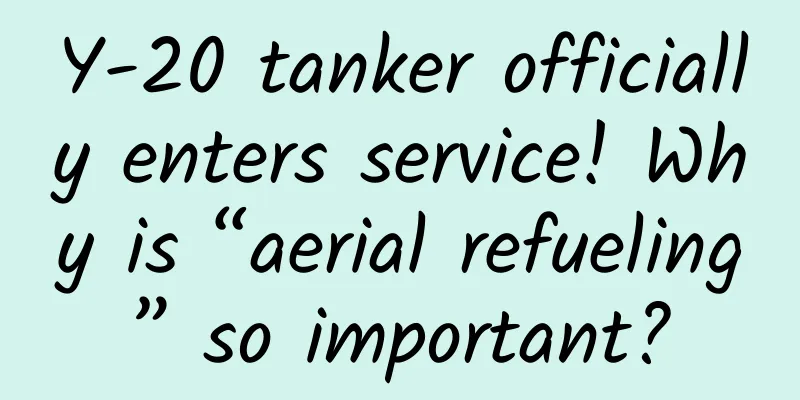Y-20 tanker officially enters service! Why is “aerial refueling” so important?

|
Recently, my country's Y-20 large aerial refueling aircraft officially entered service. Why do major air forces attach great importance to the research and development of aerial refueling aircraft? What are the advantages of aerial refueling? Compiled by New Media Editor Duan Dawei On July 31, the Air Force made a rare public announcement at a press conference at the Changchun Air Show that the domestically produced Y-20 has officially entered service with the Air Force and has recently completed aerial refueling training at sea with the J-16 heavy fighter. Fighter aircraft receiving aerial refueling and fighter aircraft returning to the base for refueling seem to be similar, so why do major air forces attach great importance to the development of aerial refueling equipment? What is the significance of aerial refueling for aircraft missions? ▲Photo of joint training between Y-20 and J-16 Aerial refueling born out of adventurous spirit Aerial refueling first appeared after the First World War. Stimulated by the adventurous spirit of aviation at that time, people first tried it. One day in July 1921, Il Mayer, a member of the American Flying Circus, organized the first aerial refueling stunt, which was a thrilling aviation show. Pilot Frank Hawke flew an SJ-1 biplane, and Il Mayer stood on the upper part of the wing with a can of gasoline tied to his back. When the plane met the "Jenny" plane driven by pilot Il Dofferty, Mayer stepped onto the wing of the "Jenny" plane on foot and poured gasoline into the tank. The audience who witnessed this aerial show were all horrified. In order to enable combat aircraft to perform long-range combat missions and extend their time in the air, some countries began to study aircraft aerial refueling technology as early as the 1920s. In 1923, the U.S. Army Air Service took the lead in using two De Harlan H4B reconnaissance aircraft to try aerial refueling with hoses. After refueling, the aircraft's flight time was increased and it was successful, thus opening the prelude to aerial refueling technology. The first use of aerial refueling technology in the military was during World War II. In retaliation for Japan's bombing of Pearl Harbor, the United States used B-25 bombers to take off from aircraft carriers, refuel in the air over Hawaii, and then flew to Japan to bomb. The aircraft is transformed into a "long-range version" Before the advent of aerial refueling technology, the range and strike range of fighter planes were limited by the amount of fuel they could carry, so countries tried their best to install large fuel tanks on fighter planes, and thus equipment such as auxiliary fuel tanks were created. However, although auxiliary fuel tanks can increase the amount of fuel a fighter plane can carry, they greatly increase flight resistance, so the effect is not satisfactory. The range of bombers is much greater than that of fighter planes, so fighter planes at that time could not provide full escort, which put bombers at risk of being shot down. Aerial refueling aircraft plays an extremely important role in the air force logistics. It can greatly extend the air and endurance of fighter jets, attack aircraft and other armed aircraft, allowing them to strengthen air superiority and increase the intensity of deep strikes. Since there is no need to land for refueling, the aircraft's dependence on airports is greatly reduced, the flight range can be doubled or even more, and the airport's dispatch space is increased. A "soft and hard" refueling device ▲Hose-cone type refueling device (Photo source: People's Daily Online) At present, there are two main types of aerial refueling devices: one is the hose-cone type (abbreviated as "soft type"), which was first developed by the United Kingdom in the late 1940s. It is mainly composed of a 22-meter to 30-meter hose and a conical funnel. When refueling, the pilot only needs to insert the front end of the receiving aircraft into the conical funnel to achieve aerial refueling. The U.S. Navy and most countries in the world that have aerial refueling aircraft generally adopt this aerial refueling method. Its advantages are that there is no need for a dedicated refueler on the aircraft, and one refueling aircraft can refuel 2 to 3 aircraft at the same time, but the refueling efficiency is relatively low. Since the hose is greatly affected by the airflow after being released, the requirements for the super-dense formation technology and aerial docking technology of the pilot of the receiving aircraft are very high. ▲Telescopic tube refueling device (Photo source: Sina.com) The other is the telescopic tube type (referred to as "hard type"), that is, a telescopic sleeve is installed at the tail of the tanker. The end of the sleeve has two symmetrical short wings. The operator can move the sleeve within a certain angle range by manipulating the short wings. When the receiving aircraft approaches the tail of the tanker, the relative positions of the two aircraft remain unchanged. The sleeve operator manipulates the short wings to extend the sleeve into the receiving aircraft's refueling port. This refueling method is relatively less affected by air currents, and docking operations are more convenient than soft refueling. The sleeve has a larger diameter and a faster refueling speed, but can only refuel one aircraft at a time. Refueling accidents are common Regardless of whether it is "soft" or "hard", both have a common premise, that is, the flight altitude, speed and direction of the tanker and the receiving aircraft must be highly consistent, the environmental conditions must also be relatively stable, and extremely high requirements are placed on the pilot's operating level. Due to the high degree of difficulty, aerial refueling accidents are not uncommon. Even the United Kingdom, which developed aerial refueling technology earlier, is often exposed to aerial refueling accidents. In August 2018, an F-35B fighter jet of the Royal Air Force flew back to the United Kingdom from South Carolina, USA across the Atlantic Ocean. During the aerial refueling docking, the probe of the receiving aircraft failed to dock successfully with the conical floating anchor of the tanker, and the floating anchor directly hit the surface of the F-35B fighter jet, causing serious damage to the stealth coating of the fighter jet. The most horrifying incident was in 1966, when a US KC-135 tanker was refueling a B-52 bomber on the Mediterranean coast, the two aircraft collided, and all seven crew members on the B-52 bomber and the KC-135 tanker were killed. What's more serious is that the B-52 bomber was carrying four hydrogen bombs at the time, two of which fell to the ground and caused nuclear contamination, and another fell into the Mediterranean Sea, and it took the US military more than two months to salvage it. On September 29, 2020, a US Marine Corps F-35B fighter jet collided with a KC-130J tanker during aerial refueling training and crashed in southeastern California. The KC-130J tanker's two engine blades on the right wing were completely damaged, and it was eventually forced to land in a farmland. Although the accident did not cause any casualties, the F-35B fighter jet was completely destroyed and could not be repaired. Why do airplanes dump fuel in mid-air? (Photo source: Tencent) In flight performances, there are often scenes where planes drag a trail of smoke across the sky, which leaves a deep impression on many people. In fact, this is a ball of fire formed by the fuel discharged from the tail fuel pipe of the aircraft during flight. However, the aircraft's mid-air fuel dumping is not just for show, but a measure to ensure flight safety and improve flight performance. Generally, an aircraft carries a large amount of fuel and payload when taking off, and the take-off weight is much greater than the weight that allows the aircraft to land safely. During normal flight, fighters consume most of the fuel. During combat, part of the carried payload will also be dropped and used, and the weight of the aircraft will be greatly reduced when returning to land, meeting the safe landing weight requirements. However, sometimes the aircraft encounters special circumstances such as equipment failure and needs to make an emergency landing. At this time, in order to meet the safe landing requirements, the pilot must dump some fuel to reduce the weight of the aircraft. (Source: Chen Shaozu. Aircraft Aerial Refueling [J]. Science for the Public: Middle School Edition, 2000(7):12-13., Xinhuanet, People's Daily Online, Sina.com, Military Sub-Plane, etc.) Produced by: Science Central Kitchen Produced by: Beijing Science and Technology News | Beijing Science and Technology Media Reproduction without authorization is prohibited |
>>: What else should you know about Chinese Valentine's Day besides dating?
Recommend
Silent mutations: a way to conquer cancer?
On the road of scientific exploration, it is ofte...
Live broadcast, interaction, personal IP, the trend of electric vehicle industry marketing gradually becoming fan circle can be stopped
If you stand in the right place, even a pig can f...
WeChat is hard to dethrone
After the “Three Heroes’ Battle of WeChat”, WeCha...
Product Operation: Is your product suitable for fission?
Regarding fission, there have been several questi...
How to avoid "playing the lute to a cow" in traffic promotion?
Who are you asking for traffic from? In ancient t...
Tesla may be suppressed if Trump is elected as US president
Republican candidate Trump was elected as the new...
The underlying logic of fission: 5 ways to swipe the screen!
We all know that fission is a popular way of play...
A fireball-shaped UFO appeared in a place late at night? Official response!
11th #It is said on the Internet that a fireball-...
Talk: How is an excellent community operated?
This article will focus on the management and dev...
Can you make a ball float in the air by just shouting? It's not magic, it's the power of sound
No one touches the ball, but it stays in the air....
APP promotion: How to cultivate core users!
Why do you want to be a core user? What is the ul...
6 ways to promote brand marketing on Xiaohongshu
Today I want to share with you some little knowle...
How to safely get vitamin D from the sun?
Vitamin D is essential for our health. It helps m...
Husband tested positive, family members not infected! Shanghai woman's "textbook-level" operation
My husband developed symptoms of cough and fever ...









